Ancient imitations of Roman coins
of
Philip I (AD 244 - 249), his wife
Otacilia
Severa, and their son, Philip II
Although the silver content of
official Philip coins was below 50%, it seems there still was profit in
making fourrees. Some, like the second and third examples below, seem
official style, but if
"plated coins are false coins," then these must be imitations. Some,
like
those of Philip II below, are very well
executed but distinctly not of official style.
Philip I (AD 244-249)

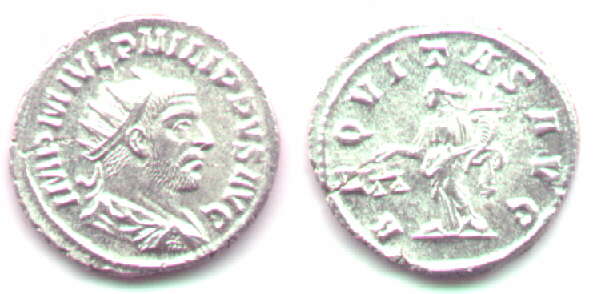
23 mm. 12:30. 5.05
grams
Its prototype
Bold obverse. Slightly crude style. Fine lettering. Thick and heavy.
IMP C M IVL PHILIPPVS PF AVG
/AEQVITAS AVG, Aequitas standing left holding
balance and
cornucopia.
RIC Philip Antioch group A for obverse legend (first issue). RIC 69-71
and
89 for the reverse type, plates 7.2 and 7.4, undated but 245-247 at
Rome.
Prototype shown: Antioch mint, not in RIC with only one G.
Cf.
RIC 27b variety of note on page 71. AR21. 6:00.

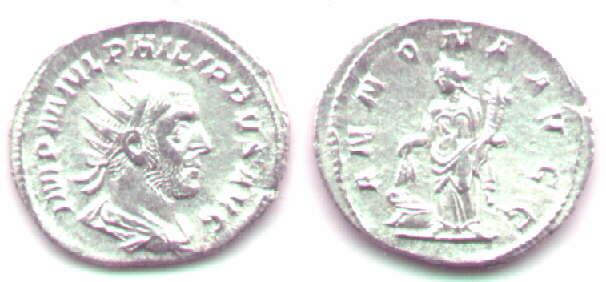
25-22 mm. 6:00. 3.68
grams
Its prototype
Extremely close to official style. Only the clear copper breaking
through the silver suggests this is irregular. This and the next coin
are food for
thought about imitations in this period. Was the official silver
content so
low that copper could break through like this? Was the mint (or, mint
workers,
unofficially) making fourrees? Or, were counterfeiters outside the mint
getting
really good at fakes?
IMP M IVL PHILIPPVS AVG
/ANNONA AVGG, Annona standing left, holding grain
over
modius, and cornucopiae
RIC 28c, plate 5.13, "244-247".
Prototype shown: RIC 29, with prow at feet to
left. AR22. 6:00.
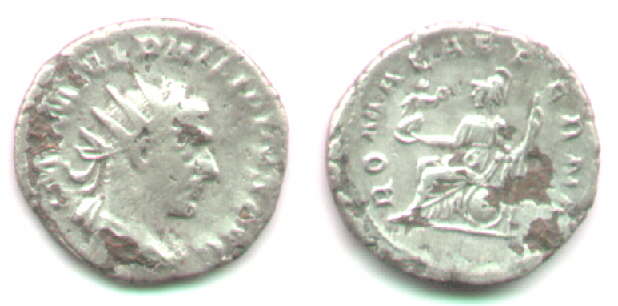
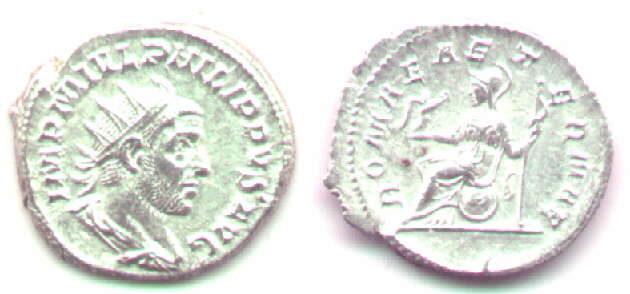
22 mm. 6:00. 3.70
grams
Its prototype
This is official style. Only the clear copper breaking through the
silver
suggests this is irregular.
IMP M IVL PHILIPPVS AVG
/ROMAE AETERNAE, Roma seated left, holding Victory
and
vertical scepter.
RIC 85, page 78, Antioch = RIC 44b Rome, page 73. AR22. 6:00.
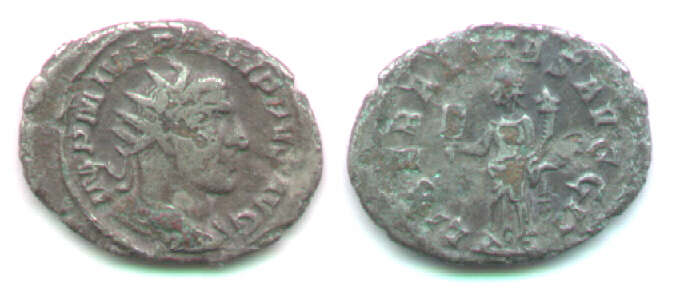
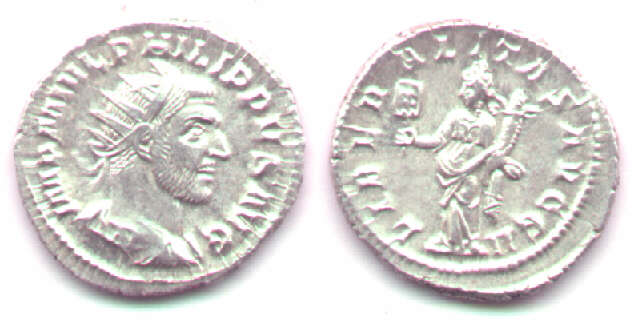
Another Philip in excellent style, with copper showing beneath the
toned
silvering, and its prototype.
This
piece: 24-20 mm. 12:00. 3.77
grams.
Prototype: AR23. 6:00. 4.44
grams.
IMP M IVL PHILIPPVS AVG
/LIBERALITAS AVGG II, Liberalitas standing holding
up
counting board, with cornucopia in left.
Prototype: Sear 2561. RIC 38b, page 72 "C, 244-247", plate 5.15.
We know that silver comes to the surface of low-silver coins when the
flan
is struck. Philip coins are less than 50 percent silver. Could it be
that
the copper showing beneath the silver is just an example of that
phenomenon?
If the surface is purer than 50% silver, that makes some of the
interior
less. Are we seeing that? Under a microscope this does not have as
clear
a differentiation between the edge of the silver and the copper as I
see
on Republican fourrees. But, it is close. The style is too good for
most
fourrees, but Philip has (see above) some good-style imitations. It is
too
close to call.
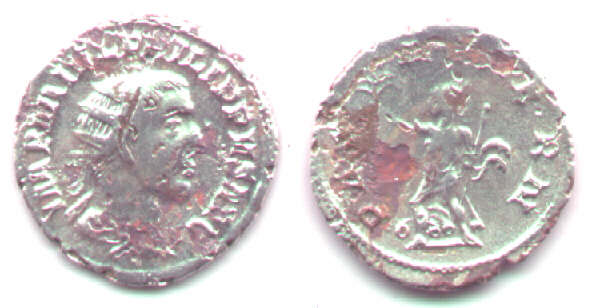 21 mm. 6:00. 2.83 grams.
21 mm. 6:00. 2.83 grams.
Most silver. Excellent lettering, but portrait style slightly off.
IMP M IVL PHILIPPVS AVG
/PAX AETERN, Pax standing left holding up olive
branch.
with scepter in left.
Prototype: Sear 2563. RIC 40b, page 73, plate 5.5, "Rome 24-247."
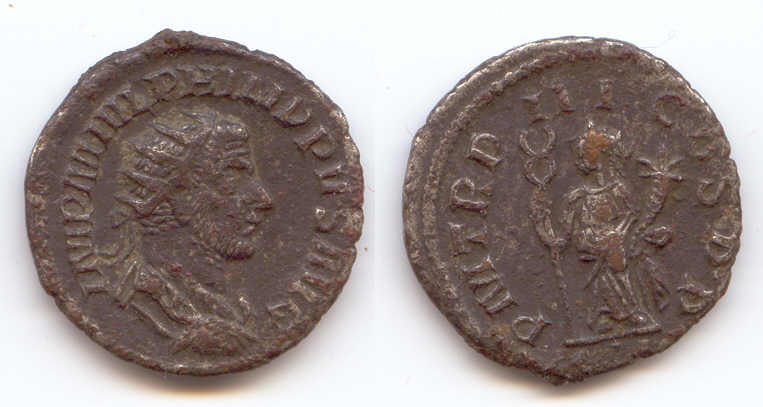 21mm. 5:30.
21mm. 5:30.
Base metal. Bold and good style, with reverse lettering perhaps a tiny
bit
large.
IMP M IVL PHILIPPVS AVG, radiate, draped, cuirassed bust right
PM TRP III COS PP, Felicitas standing left, holding
long
caduceus and cornucopia.
Prototype: RIC 3, page 68, "AD 246". Hunter 67.4.
Otacilia
Severa
 22-21 mm. 5:30. 4.49 grams (heavy)
22-21 mm. 5:30. 4.49 grams (heavy)
A thick and heavy imitation in good, but not quite official, style.
MARCIA OTACIL SEVERA AVG
/IVNO CONSAVAT [approximately, intending IVNO
CONSERVAT]
Juno standing with patera and scepter.
A hybrid. RIC 127 (AD 246-248) has this reverse with the "M
OTACIL ..."
obverse legend. RIC says of the prototype it is "probably of Antioch,
but
listed here [with Rome] becaue there is still a doubt." Given the
number
large number of imitations of coins of the Antioch mint that I have
been
seeing recently, I'd agree the prototype is probably from Antioch.
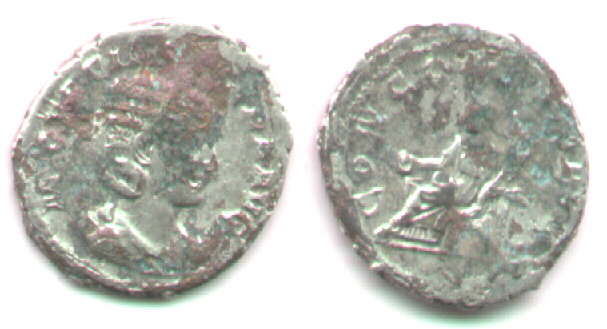
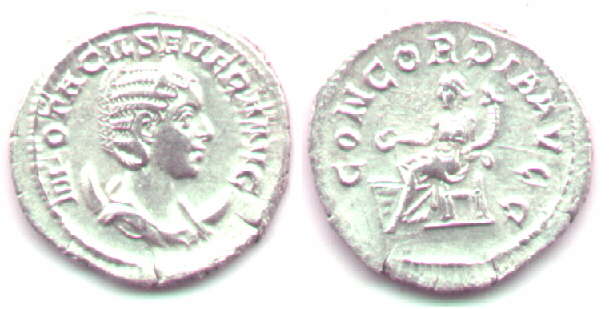
23-21 mm. 6:30. 4.12
grams
Its prototype.
M OTACIL [SEV]ERA AVG
/CONCORDIA AVGG, Concordia seated left with patera
and
cornucopia.
Prototype: RIC 126, page 84 "c. 246-8" plate 7.13. AR23-22,
12:30.
Philip
II (son of Philip I, Caesar 244-247 and Augustus 247-249)
 23 mm. 12:00. 4.09 grams
23 mm. 12:00. 4.09 grams
A lovely bold piece, very well engraved, but not quite official style.
M IVL PHILIPPVS CAES
/PAX AETERNA, Pax standing left, holding up branch
and
with transvers scepter.
RIC --, but both obverse and reverse are common. Obverse legend of Rome
as
Caesar RIC 213-221 with reverse as Augustus, RIC 227, plate 8.12, page
97.
Also, mint of Antioch "hybrids" RIC 250, page 100. Reverse of
Philip
I dated 244 on page 56.
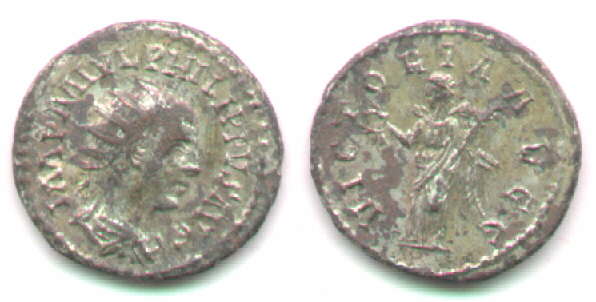 21 mm. 12:00. 3.75 grams
21 mm. 12:00. 3.75 grams
Lettering sharp and correct, but slightly irregular style.
IMP M IVL PHILIPPVS AVG
/VICTORIA AVGG, Victory standing left holding wreath
and
palm
Hybrid. RIC 51 of Philip, plate 5.10, but portrait of Philip II.
Hunter
67.24.
 21
mm. 12:00. 3.77 grams.
21
mm. 12:00. 3.77 grams.
This one is a real puzzle! The style is perfect and the coin is
struck and sharp. I would call it certainly official except for one
obvious thing -- there appear to be regions of copper below a thin (but
not extremely thin) surface layer of silver. The surface-silver seems
to be in a distinct layer, and the metal below is without visible
silver -- so it is a fourrée (isn't it?). But, how did a
fourrée turn out to have such perfect style?
Can we decide that official mint workers made it?
Or, is the silver in this time period of such low fineness that the
separation of surface-silver known to occur when coins are struck
produced this extreme example? I held this one for a year
before putting it up on this site because I didn't know what to
think. I incline toward official with accidental surface enrichment, but am not confident.
Continue with imitations
of Trajan Decius and Trebonianus Gallus.
Return to the index page on Severan and third-century imitations.
Return to the main Table of Contents page on ancient
Roman imitations.








 21 mm. 6:00. 2.83 grams.
21 mm. 6:00. 2.83 grams. 
 22-21 mm. 5:30. 4.49 grams (heavy)
22-21 mm. 5:30. 4.49 grams (heavy) 

 23 mm. 12:00. 4.09 grams
23 mm. 12:00. 4.09 grams  21 mm. 12:00. 3.75 grams
21 mm. 12:00. 3.75 grams  21
mm. 12:00. 3.77 grams.
21
mm. 12:00. 3.77 grams.